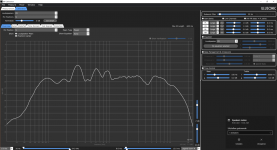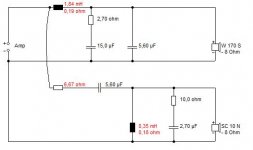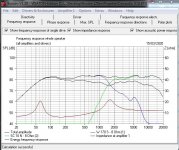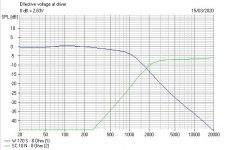Dear all here!
Having bought the Dynaudio Excite X18 some time ago, I was never really happy with them.
I could hear their strengths but also their weaknesses, especially in the treble range that to my ears sounded kinda weird.
Unable financially and practically to try different amplifiers I started to look at
the crossover network.
I already had seen some pictures of them and felt a bit disappointed.
Could it be that there was more to be had from better crossover components?
I know this is a difficult subject and some would protest changing anything to get them sound better to my ears and in my system.
So one day I opened the cabinet to look a the crossover and drew up the schematic.
What struck me most was the parallel capacitor to the midwoofer, a Bennic bipolar capacitor!
Having build several loudspeakers in my youth I thought this was a big no no.
In the house were already two sets of Clarity caps, ESA and CSA.
I had originally planned to only change the series cap to the tweeter but after discovering the bipolar parallel to the midwoofer I had to change that one also.
Understanding that these are build to a price and probable price associated amplifiers
I wonder how far I can take this till I reach the limit imposed by the drivers and cabinet themself.
So far I can say that the most remarkable change is them sounding more natural to me.
The treble stange ness is gone and a lot more leading edge definition came to many instruments even synthesizers and keyboards that I never heard before.
Now the question is did I change the frequency balance by going from the Bennic bipolar to the CC ESA capacitors with regards to the ESR being lower on the CC ESA and from the
Bennic polyprop to the CC CSA?
Any input will be highly appreciated!
Having bought the Dynaudio Excite X18 some time ago, I was never really happy with them.
I could hear their strengths but also their weaknesses, especially in the treble range that to my ears sounded kinda weird.
Unable financially and practically to try different amplifiers I started to look at
the crossover network.
I already had seen some pictures of them and felt a bit disappointed.
Could it be that there was more to be had from better crossover components?
I know this is a difficult subject and some would protest changing anything to get them sound better to my ears and in my system.
So one day I opened the cabinet to look a the crossover and drew up the schematic.
What struck me most was the parallel capacitor to the midwoofer, a Bennic bipolar capacitor!
Having build several loudspeakers in my youth I thought this was a big no no.
In the house were already two sets of Clarity caps, ESA and CSA.
I had originally planned to only change the series cap to the tweeter but after discovering the bipolar parallel to the midwoofer I had to change that one also.
Understanding that these are build to a price and probable price associated amplifiers
I wonder how far I can take this till I reach the limit imposed by the drivers and cabinet themself.
So far I can say that the most remarkable change is them sounding more natural to me.
The treble stange ness is gone and a lot more leading edge definition came to many instruments even synthesizers and keyboards that I never heard before.
Now the question is did I change the frequency balance by going from the Bennic bipolar to the CC ESA capacitors with regards to the ESR being lower on the CC ESA and from the
Bennic polyprop to the CC CSA?
Any input will be highly appreciated!
If you are changing the ESR significantly, then yes.
Given the measured FR though, I would not have advised you to do a straight part swapping for it. Dynaudio often has specific signatures they are trying with different speakers. W, V shaped, and in this case, a shelved up treble.
My advice is, if you are going to spend a little, swap tweeter caps for fun.
If you are going to do more, make sure you like the signature and impedance curves before you commit. A crossover rework is sometimes required. Based on this, I'd say you probably want to lower the treble output 2 to 4 dB
Seen here:
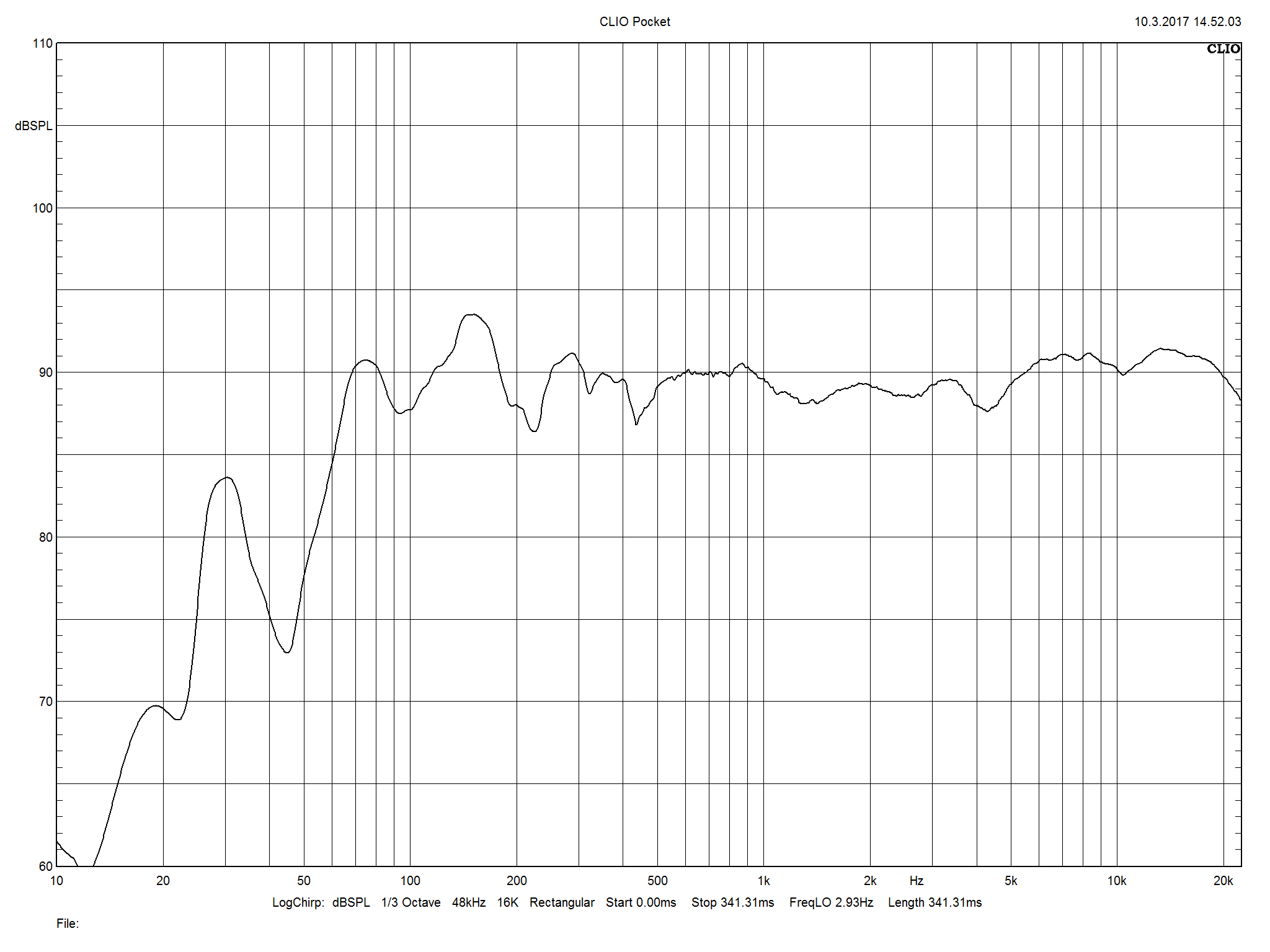
but really, the least expensive, least frustrating way to go about this is to do a full speaker analysis first. Simulate the whole thing, and then see what you want the speaker to sound like when you are done.
I've gone down the road of "i'm just going to swap a cap here and there" before, and then ended up redoing the whole crossover. Not part swapping, part re-imagining, so I essentially paid for a new crossover twice...... hopefully you won't make these mistakes.
Given the measured FR though, I would not have advised you to do a straight part swapping for it. Dynaudio often has specific signatures they are trying with different speakers. W, V shaped, and in this case, a shelved up treble.
My advice is, if you are going to spend a little, swap tweeter caps for fun.
If you are going to do more, make sure you like the signature and impedance curves before you commit. A crossover rework is sometimes required. Based on this, I'd say you probably want to lower the treble output 2 to 4 dB
Seen here:

but really, the least expensive, least frustrating way to go about this is to do a full speaker analysis first. Simulate the whole thing, and then see what you want the speaker to sound like when you are done.
I've gone down the road of "i'm just going to swap a cap here and there" before, and then ended up redoing the whole crossover. Not part swapping, part re-imagining, so I essentially paid for a new crossover twice...... hopefully you won't make these mistakes.
Last edited:
Wow thank you for your quick response Eric!
It must be my aging ears as I never considered the treble being tipped up!
Perhaps the softer sound of the CC CSA makes it better to my ears.
I haven't measured the ESR of the Bennic bipolar so not sure on that one yet.
Perhaps some one did?
Best regards, Veeren
It must be my aging ears as I never considered the treble being tipped up!
Perhaps the softer sound of the CC CSA makes it better to my ears.
I haven't measured the ESR of the Bennic bipolar so not sure on that one yet.
Perhaps some one did?
Best regards, Veeren
Last edited:
It was smart of you to turn to the crossover. I understand that Dynaudios have a good reputation. They were also popular during the time when simple crossovers were popular.
I would turn my attention to choosing the best crossover frequency, the best slopes and the overall balance.
I would turn my attention to choosing the best crossover frequency, the best slopes and the overall balance.
I use electrolytics all the time, keeping in mind parasitics.did I change the frequency balance
Having looked at the crossover schematic I have two questions:
Can I make a HF compensation tilt up from 5 khz by bypassing the 3k9 resistor in series with the tweeter with a capacitor and what value would that be?
Also there is a parallel compensation network to the tweeter of 2µ7 +10 Ohm any idea what that does?
Thankful for all your answers!
Best regards, Veeren
Can I make a HF compensation tilt up from 5 khz by bypassing the 3k9 resistor in series with the tweeter with a capacitor and what value would that be?
Also there is a parallel compensation network to the tweeter of 2µ7 +10 Ohm any idea what that does?
Thankful for all your answers!
Best regards, Veeren
Actually that crossover is not quite the whole picture:
Bass pictured is big coil and 5.6uF and 15uF NPE types. All Bennic.
Tweeter is 2.7uF, small coil and 5.6uF MKP by the look of things.
Makes no sense at all.
Gets better when you find a couple of 2R7 and 3R9 10W ceramics on the back of the board:
Dynaudio Excite X 18 im Test: die feine Kompaktbox.
It's all a waste of time without a schematic, but I would think we are looking at a big bass coil with a 3R9/15uF Zobel, and 5.6uF shunt, suggesting 4 ohm bass.. Tweeter likely 3rd order with a 2R7 attenuator.
Dynaudio 6" polycone drivers are quite well-behaved:
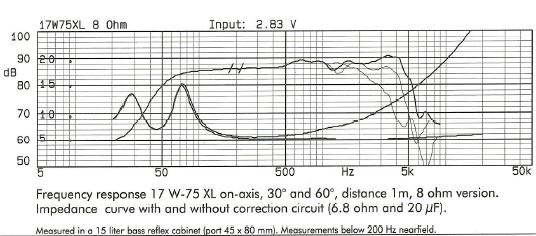
Esostar and Esotec tweeters are flat and can handle high excursion:
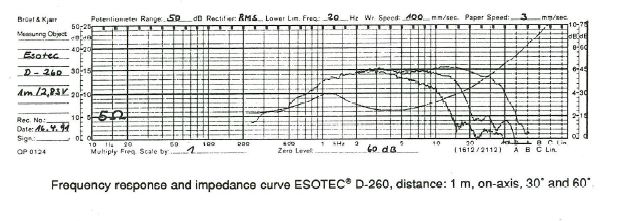
Typical vintage Dynaudio crossover, here impedance corrected:
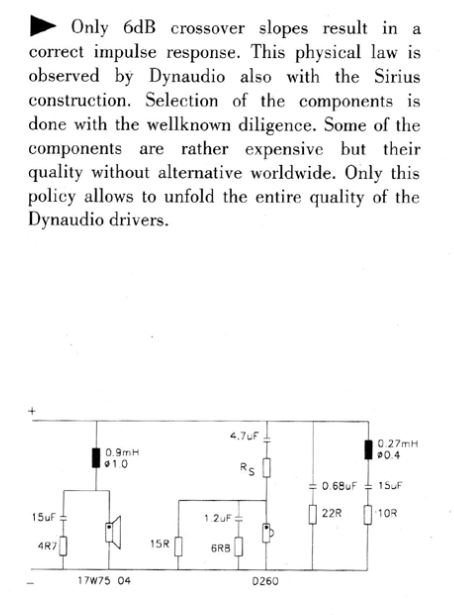
Just setting out the problem...
Bass pictured is big coil and 5.6uF and 15uF NPE types. All Bennic.
Tweeter is 2.7uF, small coil and 5.6uF MKP by the look of things.
Makes no sense at all.
Gets better when you find a couple of 2R7 and 3R9 10W ceramics on the back of the board:
Dynaudio Excite X 18 im Test: die feine Kompaktbox.
It's all a waste of time without a schematic, but I would think we are looking at a big bass coil with a 3R9/15uF Zobel, and 5.6uF shunt, suggesting 4 ohm bass.. Tweeter likely 3rd order with a 2R7 attenuator.
Dynaudio 6" polycone drivers are quite well-behaved:
Esostar and Esotec tweeters are flat and can handle high excursion:
Typical vintage Dynaudio crossover, here impedance corrected:
Just setting out the problem...
Last edited:
As mister PeteMcK pointed out, and to further introduce some sense in this thread, measurements shown for Dynaudio Excite X14 from Stereophile, prove that neither tweeter itself, nor the crossover filter, are the cause of any lack of high frequencies.
That Dutch review is irrelevant in this sense. Dynaudio tweeters traditionally are revealing, as is any other of such technology and we know there is lots of them.
To confuse an audiophile these days has become such an easy task, you just have to write a nonsense review on a nonsense blog site, and offer as a remedy a product that has a name something to do with supremacy or being clear or whatever. Yes, and the cap wires get to wear socks, pardon me, insulation.
That Dutch review is irrelevant in this sense. Dynaudio tweeters traditionally are revealing, as is any other of such technology and we know there is lots of them.
To confuse an audiophile these days has become such an easy task, you just have to write a nonsense review on a nonsense blog site, and offer as a remedy a product that has a name something to do with supremacy or being clear or whatever. Yes, and the cap wires get to wear socks, pardon me, insulation.

OP is asking for Excite X18, which may have different frequency response than Excite X14.
Thank you all for responding!
To take the mystery out of the crossover network I will elaborate here:
The bass-mid section consists of a coil with metal core of unknown value
in series with the BM driver.
Parallel to the BM driver a zobel of 15µf bipolar in series with 2,7 Ohm.
Parallel to the BM driver a 5µ6 bipolar.
The tweeter section consists of a unknown air coil parallel to the HF driver.
Parallel to the HF driver 10 Ohm in series with a 2µ7 bipolar.
In series with the HF driver 3,9 Ohm with 5µ6 in series.
Sorry I cannot draw a crossover schematic on my computer.
Best regards, Veeren
To take the mystery out of the crossover network I will elaborate here:
The bass-mid section consists of a coil with metal core of unknown value
in series with the BM driver.
Parallel to the BM driver a zobel of 15µf bipolar in series with 2,7 Ohm.
Parallel to the BM driver a 5µ6 bipolar.
The tweeter section consists of a unknown air coil parallel to the HF driver.
Parallel to the HF driver 10 Ohm in series with a 2µ7 bipolar.
In series with the HF driver 3,9 Ohm with 5µ6 in series.
Sorry I cannot draw a crossover schematic on my computer.
Best regards, Veeren
Just to demystify the polycone Dynaudio drivers, they get quite close to some other popular 6" polycones::

Peerless 830874:
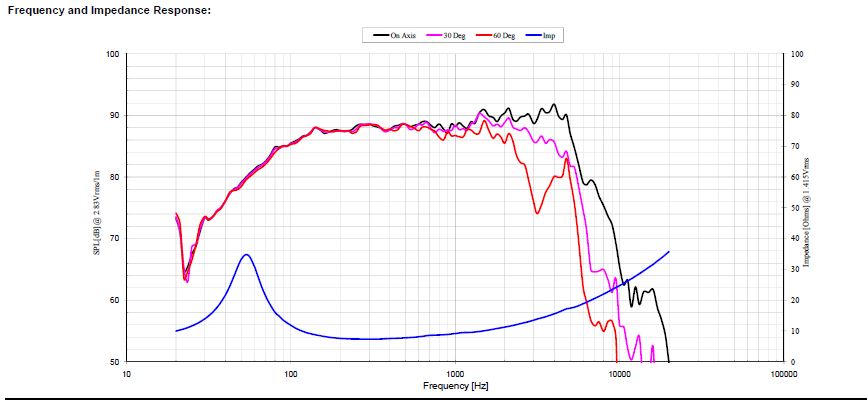
SEAS U18RNX-P:
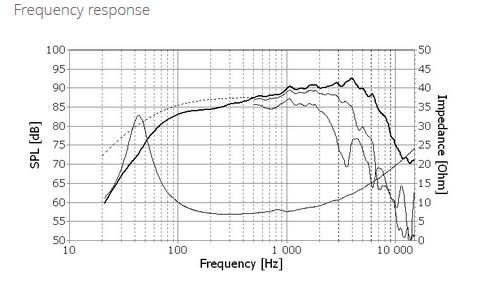
All with breakup problems around 4kHz, which can be dealt with.
Anyhoo, here's my guesses on the Dynaudio X18.
What's the question?
Peerless 830874:
SEAS U18RNX-P:
All with breakup problems around 4kHz, which can be dealt with.
Anyhoo, here's my guesses on the Dynaudio X18.
What's the question?
Attachments
Dear Steve,
The dynaudio woofer is 4 Ohm as far as I know.
Having replaced the parallel to the woofer capacitor that was a Bennic B03 bipolar with a CC CSA cap I was wondering if I changed the frequency response as I heard quite a difference in the sound as described earlier on in my post.
I still am puzzled by the HF drop in the measurements I have seen and what I hear.
Is the 2µ7 with 10 Ohm in series paralel to the HF driver a HF compensation network or just impedance correction.
Many thanks to all!
The dynaudio woofer is 4 Ohm as far as I know.
Having replaced the parallel to the woofer capacitor that was a Bennic B03 bipolar with a CC CSA cap I was wondering if I changed the frequency response as I heard quite a difference in the sound as described earlier on in my post.
I still am puzzled by the HF drop in the measurements I have seen and what I hear.
Is the 2µ7 with 10 Ohm in series paralel to the HF driver a HF compensation network or just impedance correction.
Many thanks to all!
Now we've got the schematic, it really all falls into place:
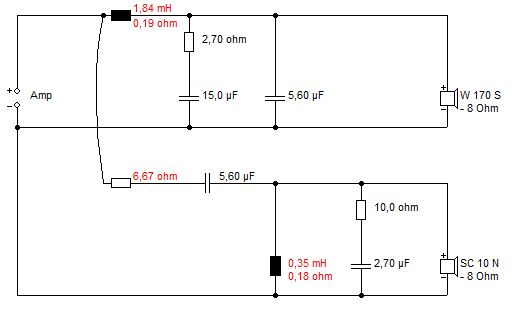
A 4 ohm woofer doesn't change the general picture, just drops the bass impedance to 4 ohms. You use a smaller bass coil too.
The bass shunt should work better with an MKP replacing a NP. You lose a little damping, but gain in quality.
It's effectively a tiny bit louder at crossover. The 2.7uF Zobel replacement MKP for MKP won't do much at all, IMO. The 10R/2.7uF Zobel damps down the top end above 5kHz very considerably, maybe 2dB. A 1uF might find a middle ground there. Bit more top-end brightness. A zobel can be impedance correction, but when used with series resistance, becomes HF rolloff too.
These are really tiny differences. I'm assuming the tweeter input is already an MKP.
Another way to do a bass filter on a driver that has good rolloff is this sort of thing:
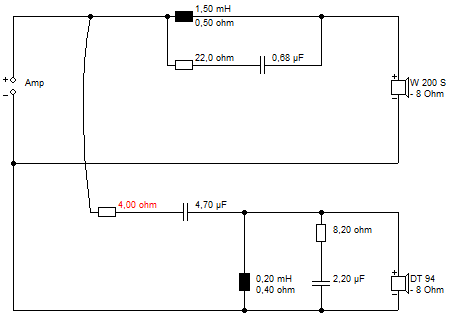
That's a 5kHz tank notch. They sound completely different from a bare coil and sort of quieter. But you need to model these things. IMO, speakers work well in well-damped rooms, but a lively room with bare floorboards an' all that can annoy. Thick carpets and thick drapes, stands and rubber feet usually help. 4 ohm speakers can stress cheaper amplifiers. TBH, I sometimes wonder if these "upgrades" sound better just because in the process you clean and retighten the speaker connections. Copper corrodes quite quickly. LOL.
A 4 ohm woofer doesn't change the general picture, just drops the bass impedance to 4 ohms. You use a smaller bass coil too.
The bass shunt should work better with an MKP replacing a NP. You lose a little damping, but gain in quality.
It's effectively a tiny bit louder at crossover. The 2.7uF Zobel replacement MKP for MKP won't do much at all, IMO. The 10R/2.7uF Zobel damps down the top end above 5kHz very considerably, maybe 2dB. A 1uF might find a middle ground there. Bit more top-end brightness. A zobel can be impedance correction, but when used with series resistance, becomes HF rolloff too.
These are really tiny differences. I'm assuming the tweeter input is already an MKP.
Another way to do a bass filter on a driver that has good rolloff is this sort of thing:
That's a 5kHz tank notch. They sound completely different from a bare coil and sort of quieter. But you need to model these things. IMO, speakers work well in well-damped rooms, but a lively room with bare floorboards an' all that can annoy. Thick carpets and thick drapes, stands and rubber feet usually help. 4 ohm speakers can stress cheaper amplifiers. TBH, I sometimes wonder if these "upgrades" sound better just because in the process you clean and retighten the speaker connections. Copper corrodes quite quickly. LOL.
Last edited:
Thanks Steve for all this!
I think I will remove the 10 Ohm resistor (lift one leg) to see if I like it better.
Yes the tweeter series capacitor is a Claritycap CSA poliprop.
I like your comment about tightening speaker connections, in my case I use banana Z plugs but I guess contact degradation happens to those also.
Specially here in this part of Portugal where the dust in the air has a nasty habit of making good looking contacts non conductive.
The connections to the drive units as well as the crossover board are all on faston connectors I bet they go wonky to!
Again many thanks!
Best regards, Veeren
I think I will remove the 10 Ohm resistor (lift one leg) to see if I like it better.
Yes the tweeter series capacitor is a Claritycap CSA poliprop.
I like your comment about tightening speaker connections, in my case I use banana Z plugs but I guess contact degradation happens to those also.
Specially here in this part of Portugal where the dust in the air has a nasty habit of making good looking contacts non conductive.
The connections to the drive units as well as the crossover board are all on faston connectors I bet they go wonky to!
Again many thanks!
Best regards, Veeren
- Home
- Loudspeakers
- Multi-Way
- Dynaudio X18 good cabinet and drivers lousy crossover?
